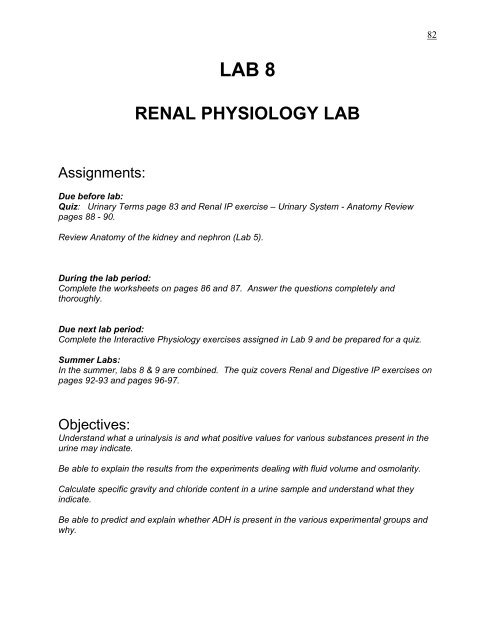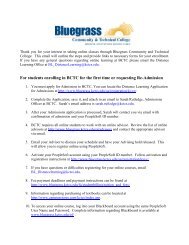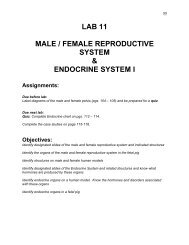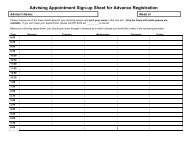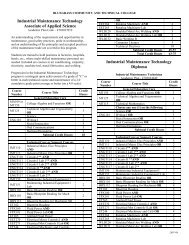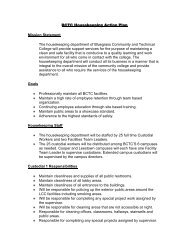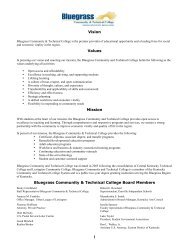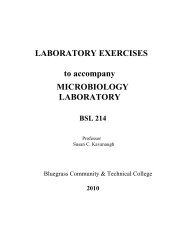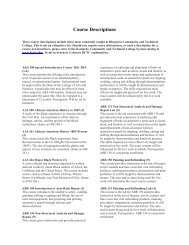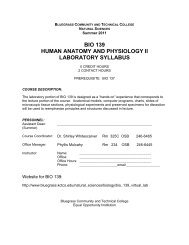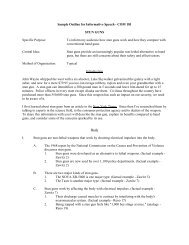RENAL PHYSIOLOGY LAB
RENAL PHYSIOLOGY LAB
RENAL PHYSIOLOGY LAB
You also want an ePaper? Increase the reach of your titles
YUMPU automatically turns print PDFs into web optimized ePapers that Google loves.
82<strong>LAB</strong> 8<strong>RENAL</strong> <strong>PHYSIOLOGY</strong> <strong>LAB</strong>Assignments:Due before lab:Quiz: Urinary Terms page 83 and Renal IP exercise – Urinary System - Anatomy Reviewpages 88 - 90.Review Anatomy of the kidney and nephron (Lab 5).During the lab period:Complete the worksheets on pages 86 and 87. Answer the questions completely andthoroughly.Due next lab period:Complete the Interactive Physiology exercises assigned in Lab 9 and be prepared for a quiz.Summer Labs:In the summer, labs 8 & 9 are combined. The quiz covers Renal and Digestive IP exercises onpages 92-93 and pages 96-97.Objectives:Understand what a urinalysis is and what positive values for various substances present in theurine may indicate.Be able to explain the results from the experiments dealing with fluid volume and osmolarity.Calculate specific gravity and chloride content in a urine sample and understand what theyindicate.Be able to predict and explain whether ADH is present in the various experimental groups andwhy.
83Urinalysis results: Learn before coming to labFindings Non-Pathological Pathological CausesProtein(Proteinuria)PregnancyHigh protein dietDamage to glomerularmembrane:Ex: GlomerulonephritisHypertensionUrea High protein intake Impaired renal functionGlucose(glycosuria)High sugar intake Diabetes mellitus(brain injury/ myocardialinfarction)KetonesLow carbohydrate diet Diabetic acidosis(ketonuria)Blood(hematuria)Menstrual contaminationStarvationUrinary tract infectionKidney stones / Renal disease(Trauma / burns /anemia /transfusion reactions)Leukocytes(pyuria)NitritesUrobilinogen(urobilinogenuria)Bilirubin(bilirubinuria)pHAcidicAlkalineContamination fromvaginal dischargeSmall amounts normalNormal range: 4.5-8.0High protein intakeVegetarian dietUrinary tract infection (kidneyinfections)GlomerulonephritisUrinary tract infections due tocertain bacteriaLiver diseaseHemolytic anemiaLiver disordersObstructed bile ductSpecific GravityDeionized waterNormal range: 1.001-1.0351.000
84Kidney Function: Regulation of extracellular volume and osmolarityPrior to Lab:AVOID VERY SALTY FOODS AND BEVERAGES CONTAINING CAFFEINE(water retaining)(diuretic)1. For the 2 hours proceeding laboratory, note the type and quantity of food andbeverages you consumed.a.b.c.d.2. Record the time of bladder emptying before coming to lab.time:During Lab:Step 1.Void urine in specimen cup and return sample to lab for testing. This first sampleis your Control Sample.Record time and volume on kidney function results page.Step 2.Drink/eat one of the following:1. 1 liter of distilled water (Water group)- hypotonic solution( approx. 4-5 glasses)2. Eat potato chips or drink tomato juice(Salt and water group)Need to have approx. 3 glasses of tomato juice or 2+ plates of potatochips with 1-2 glasses of distilled wateror3. Do not eat or drink anything (Control group)IF YOU HAVE HIGH BLOOD PRESSURE DO NOT CHOOSE THE HIGH SALT GROUP
85Step 3.Do a urinalysis on your Control Sample.Check physical characteristics and use a Chemstrip - record your results onChemstip results page.Also do a specific gravity on your urine and test for chloride content. Recordthese values on Kidney function results page.Directions:1. Specific gravity – using the Refractometer:Raise the plexiglass cover and place one drop of urine on the blue prism.Carefully lower the cover.While looking through the blue dot in the eyepiece, press the button ontop of the refractometer to turn on the light. Read the scale on the farright.The reading is taken at the interface of the dark and light blue fields.(Distilled water is 1.000)2. Chloride content - place test tube in rack. Add:0.5 ml of urine using transpet.one drop of 20% potassium chromate to urine and shake. The solutionwill be yellow.add 2.9% silver nitrate one drop at a time, gently shaking after each drop.Count the number of drops required to form a brick-red precipitate.Remember to gently shake the solution because you will see a transitoryprecipitate before the end point of your titration is reached. Each dropequals 61 mg of Cl - per 100 ml. Thus, multiply number of drops by 0.61to calculate the concentration of Cl - in mg/ml. Record on chart.The metal chromium should NOT go down the drain. Please empty testtube into marked waste container before rinsing at sink.Step 4.After drinking solution, urine is voided every 30 minutes.For each urine sample record volume, specific gravity and chloride content onkidney function results chart.
86CHEMSTRIP RESULTSTest Normal values ResultsWBCs/leukocytesnegativeNitritesnegativepH 4.5 - 8.0Protein/AlbuminGlucoseKetone bodiesUrobilinogenBilirubinBlood/hemoglobinnegativenegativenegativenegativenegativenegativeKIDNEY FUNCTION RESULTSTreatment Group _____________________Time(previous)Volume(ml)SpecificGravityCl - Content(mg/ml)( U Cl )U Control U1 U2 U3Control Time (min): Time (min): Time (min):Time (min):*Urine FlowRate ( v )(ml/min)**UE of Cl(V x U Cl )(mg/min).* Urine Flow Rate (v): Divide the ml of urine by the number of minutes since the last urine collectionCompare results with others in same treatment group. Are your results inagreement with others? If not, what might be causing the differences?**UE of Cl:Multiply Urine chloride content by the urine flow rate (v x U CL).
87Explain what happens to urine flow rate, specific gravity and urinary excretion of chloride ineach group (put ↑ or ↓). Explain the physiological mechanisms involved (Ex: ADHstimulated or inhibited because…) in the results from each group:1. Distilled water- 1 L (Hypotonic)urine flow rate (v)Specific GravityChloride Content (U CL )Urinary Excretion of Chloride (UE CL )ADH2. Salt and Water Group (Potato chips and water) – (Isotonic)urine flow rate (v)Specific GravityChloride content (U CL )Urinary Excretion of Chloride (UE CL )ADH3. No water – control – (hypertonic)urine flow rate (v)Specific GravityChloride Content (U CL )Urinary Excretion of Chloride (UE CL )ADH
88View the Urinary System – Anatomy Review on the Interactive Physiology CD, answerthe questions on pages 88 - 90 and be prepared for a quiz.Urinary System – Anatomy Review1. Name the organs in the urinary system:1. ____________________2. ____________________3. ____________________4. ____________________2. The kidneys are _____________________ (behind the peritoneum) lying against thedorsal body wall in the upper abdomen.3. The ________________ gland sits atop the kidneys. Blood vessels enter and leavethe kidney at the renal ____________.4. The functional units of the kidney are the _______________. They are called________________ ____________ if they are located mainly in the cortex. They arecalled ___________________ _____________ if they are located in both the cortexand medulla.5. Blood enters the kidney through the ___________ artery. The artery branches intosmaller and smaller arteries and arterioles. Complete the sequence below:_________________ arteriole_________________ arteriole______________ capillaries________________ capillaries and vasa recta
896. Complete the sequence below showing all parts of the nephron:Bowman’s Capsule ____________ convoluted tubule _________________(both descending and ascending limb________________ convoluted tubule________________ (both cortical and medullary sections)7. The renal corpuscle consists of two parts: __________________ capillaries and_____________________________ A portion of the plasma is filtered into thecapsular space due to the hydrostatic pressure of the blood.8. The filtration membrane consists of:__________________ capillary endotheliumporous _______________ membrane andthe ___________________ (which contain filtration slits).This filtration membrane permits (large or small) molecules to be filtered.9. Proximal tubule: The simple cuboidal cells of the proximal tubule are called____________________ cells because they contain numerous microvilli. Themicrovilli increase the ____________________ for reabsorption.The proximal tubule cells are highly permeable to water and many solutes. The______________________permit the movement of water between the cells.10. Loop of Henle : The thin descending limb of the loop of Henle is highly permeableto ______________ but not to ____________.The thin ascending limb of the loop of Henle is highly permeable to______________ but not to _____________.
9011. The thick ascending limb of the loop of Henle runs back between the afferent andefferent arterioles as they enter and leave Bowman’s capsule. The juxtaglomerularapparatus consists of the ___________________ cells of the tubule and the____________________ (modified smooth muscle) cells of the afferent arteriole.______________ cellsthe arteriole.serve as baroreceptors sensitive to blood pressure within______________ cellselectrolyte composition) of the filtrate in the tubule.monitor and respond to changes in the osmolarity (or12. After the juxtaglomerular apparatus, the tubule becomes the distal tubule. The latedistal tubule and cortical collecting duct contain two functional types of cells:_________________ cells hormones regulate their permeability to water andsolutes._________________ cells these cells secrete hydrogen ions for acid/baseregulation.13. The medullary collecting duct is composed of ____________ cells.Their permeability to _________ and ____________ is hormonally regulated.


